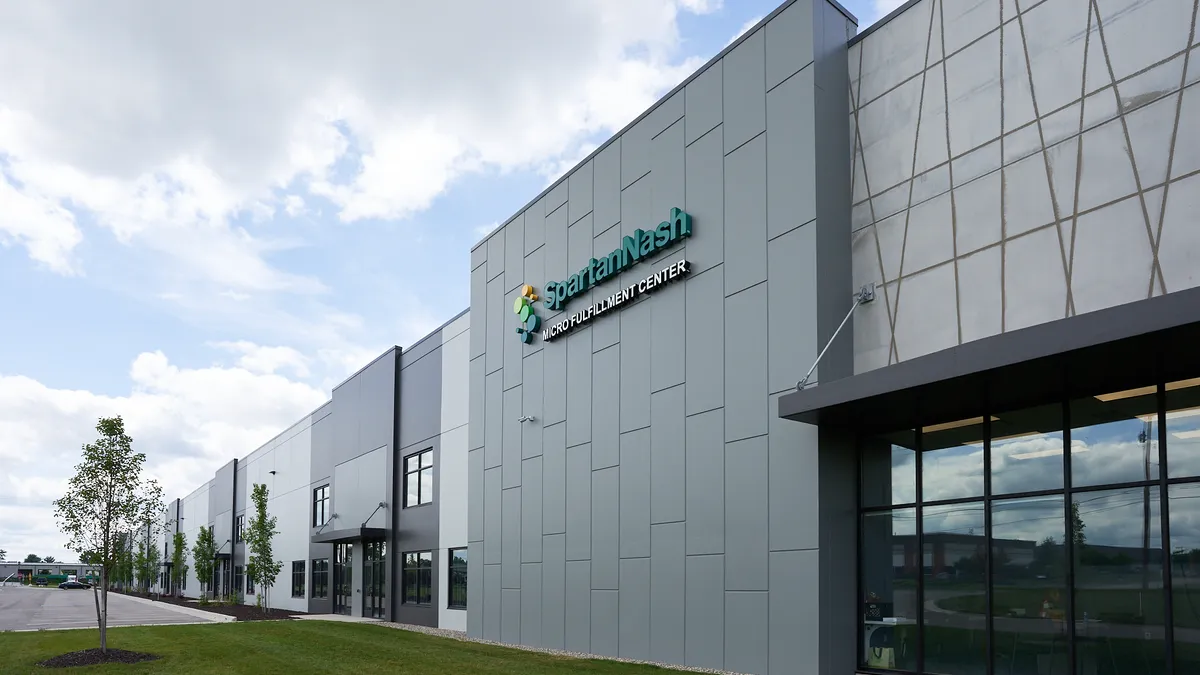Dive Brief:
- SpartanNash saw a 9.1% year-over-year increase in same-store sales during its fourth quarter of 2022, which ended on Dec. 31, 2022, and a 7.7% bump for the fiscal year, the grocery distributor and supermarket operator reported on Thursday.
- For the quarter, the company recorded net earnings of $0.7 million, a 97% decrease compared to the $22.2 million logged in the prior year’s quarter, Chief Financial Officer Jason Monaco told investors during the earnings call, according to a Seeking Alpha transcript. For the fiscal year, net earnings were $34.5 million, down over 50% from the prior fiscal year, Monaco said.
- The company is expecting inflation to continue but moderate throughout 2023 and that it will keep seeing weakness in unit volume, Monaco said.
Dive Insight:
SpartanNash’s stock tanked Thursday after the company's Q4 adjusted earnings per share of $2.33 missed analysts’ estimates.
Monaco said that the net earnings results were in part due to a steep increase in interest rates that led to a $5.1 million increase in its expenses.
Operating expenses, as a percent of sales, increased 0.58% from the year prior, largely due to lapping the changes to the company’s paid time off policy, Monaco said. Steeper corporate administrative costs also led to the increase in expenses, he said.
“The increases in expenses were partially offset by a reduction in the supply chain expenses driven by our supply chain transformation initiatives, as well as lower healthcare insurance costs,” Monaco told investors.
The company’s net sales year-over-year growth of more than 10% in the quarter was largely driven by inflation seen in both its wholesale and retail segments, Monaco said.
For Q4, basket sizes were up about 8.5% and traffic was up roughly 1.5%, Tony Sarsam, the grocery company’s president and chief executive officer said during the earnings call. He noted that customers are seeking mix and value, spotlighting meat as one area: “People are looking for ways to get to reasonable deals on protein and so we saw more growth on hamburger and chicken during the quarter.” The comp store sales increase was partially offset by a 2.1% decline in unit volumes, executives said.
Sarsam said private brands saw strong growth in the quarter, up 18.5%, and increases in penetration for both the quarter and fiscal year.
“That growth rate is about roughly 2.5x the growth rate of the national brands, so we see people who are finding own brands as a solid replacement, a good quality product at a lower price,” Sarsam said. “And we saw that in every quarter of last year, and it was particularly strong in the fourth quarter.”
“In the quarter, our sales and our own brand and our retail operations were more than double the growth that we saw across all of our retail business, and that included not just dollars but unit growth,” Monaco said.
Sarsam highlighted three main areas as he discussed SpartanNash’s performance during FY 2022: cost savings tied to the company’s supply chain transformation; new consumer offerings through partnerships with DoorDash, Uber and Shipt; and progress on the company’s merchandising transformation.
The latter contributed to the company’s higher corporate administrative costs but is expected to start providing financial benefits in late Q1, executives noted.
“During the first quarter of 2023 we will cycle significant inflation-related price change benefits, also known as forward buy of nearly $10 million. In addition, we will also be cycling $4 million in retail wage investments that were implemented at the end of first quarter last year,” Monaco said. “We expect that our supply chain and merchandising transformation initiatives will offset some, but not all of these headwinds in the first quarter of 2023.”
The supply chain transformation helped SpartanNash gain wholesale segment share and secure by the end of the year more than $25 million in run rate costing savings, Sarsam noted.
“We expect our supply chain transformation to make even greater strides in 2023, which includes custom operational plans for each distribution center,” Sarsam said.
Executives also highlighted the recent acquisition of independent grocery wholesaler Great Lake Foods along with its 300,000-square-foot distribution center that serves the Midwest region.
For the fiscal year ahead, the company expects net sales will range between $9.9 billion and $10.2 billion and that its adjusted earnings per share will fall between $2.20 and $2.35.
The company’s FY 2023 guidance includes planned capital expenditures in the range of $130 million to $145 million. SpartanNash also predicts its wholesale net sales will grow 4% to 7%, inclusive of the Great Lakes Foods acquisition, and that retail comp sales will grow 2% to 5%.
SpartanNash raised its 2025 long-term sales target to $10.5 billion. By the end of that same year, SpartanNash is aiming to have a quarter of its stores remodeled, Sarsam said.












